I want to draw edges of an object with hidden edges removed. The idea I want to apply is to render the object's faces first to the depth buffer, then in a second pass drawing the edges with depth testing enabled.
Since not all triangle edges should be visible, the edges are stored separately (simple example: in a cube, the diagonal edges should not be visible, although they are there since a quad is rendered as two triangles). The faces are therefore drawn using GL_TRIANGLES, the edges are drawn uing GL_LINES with a separate vertex buffer.
The problem is that hidden edges are partly shown with this setup, and that visible edges are partly hidden. How can I achieve a proper result?
without depth testing:

with depth testing:

faces which are rendered to depth buffer:

I use a framebuffer with an attached color and depth buffer to draw my object.
// Color buffer setup.
glBindTexture(GL_TEXTURE_2D, objectEdges);
glTexParameteri(GL_TEXTURE_2D, GL_TEXTURE_MIN_FILTER, GL_LINEAR);
glTexParameteri(GL_TEXTURE_2D, GL_TEXTURE_MAG_FILTER, GL_LINEAR);
glTexParameteri(GL_TEXTURE_2D, GL_TEXTURE_WRAP_S, GL_CLAMP_TO_EDGE);
glTexParameteri(GL_TEXTURE_2D, GL_TEXTURE_WRAP_T, GL_CLAMP_TO_EDGE);
glTexImage2D(GL_TEXTURE_2D, 0, GL_RGBA, 640, 360, 0, GL_RGBA, GL_UNSIGNED_BYTE, nil);
// Depth buffer setup.
glBindRenderbuffer(GL_RENDERBUFFER, objectFaces);
glRenderbufferStorage(GL_RENDERBUFFER, GL_DEPTH_COMPONENT16, 640, 360);
// Framebuffer setup.
glBindFramebuffer(GL_FRAMEBUFFER, framebuffer);
glFramebufferTexture2D(GL_FRAMEBUFFER, GL_COLOR_ATTACHMENT0,
GL_TEXTURE_2D, objectEdges, 0);
glFramebufferRenderbuffer(GL_FRAMEBUFFER, GL_DEPTH_ATTACHMENT,
GL_RENDERBUFFER, objectFaces);
assert(glCheckFramebufferStatus(GL_FRAMEBUFFER) == GL_FRAMEBUFFER_COMPLETE);
assert(glGetError() == GL_NO_ERROR);
This setup works without any problems. I draw my object as following:
glEnable(GL_DEPTH_TEST);
glDepthFunc(GL_LEQUAL);
glBindFramebuffer(GL_FRAMEBUFFER, framebuffer);
glClear(GL_COLOR_BUFFER_BIT | GL_DEPTH_BUFFER_BIT);
glColorMask(GL_FALSE, GL_FALSE, GL_FALSE, GL_FALSE);
glDepthMask(GL_TRUE);
glBindVertexArrayOES(vertexArray_faces);
glDrawArrays(GL_TRIANGLES, 0, vertexCount_faces);
glBindVertexArrayOES(0);
glColorMask(GL_TRUE, GL_TRUE, GL_TRUE, GL_TRUE);
glDepthMask(GL_FALSE);
glBindVertexArrayOES(vertexArray_edges);
glDrawArrays(GL_LINES, 0, vertexCount_edges);
glBindVertexArrayOES(0);
glDisable(GL_DEPTH_TEST);
The used shader is just a standard model-view-projection vertex shader, and a fragment shader which outputs white for all fragments.
GLKMatrix4 projectionMatrix =
GLKMatrix4MakePerspective(
GLKMathDegreesToRadians(65.0f), 640.0 / 360.0f, 0.01f, 10.0f);
GLKMatrix4 modelViewMatrix =
GLKMatrix4MakeLookAt(0.2f, 0.4f, 0.2f, 0.2f, 0.0f, 0.0f, 0.0f, 1.0f, 0.0f);